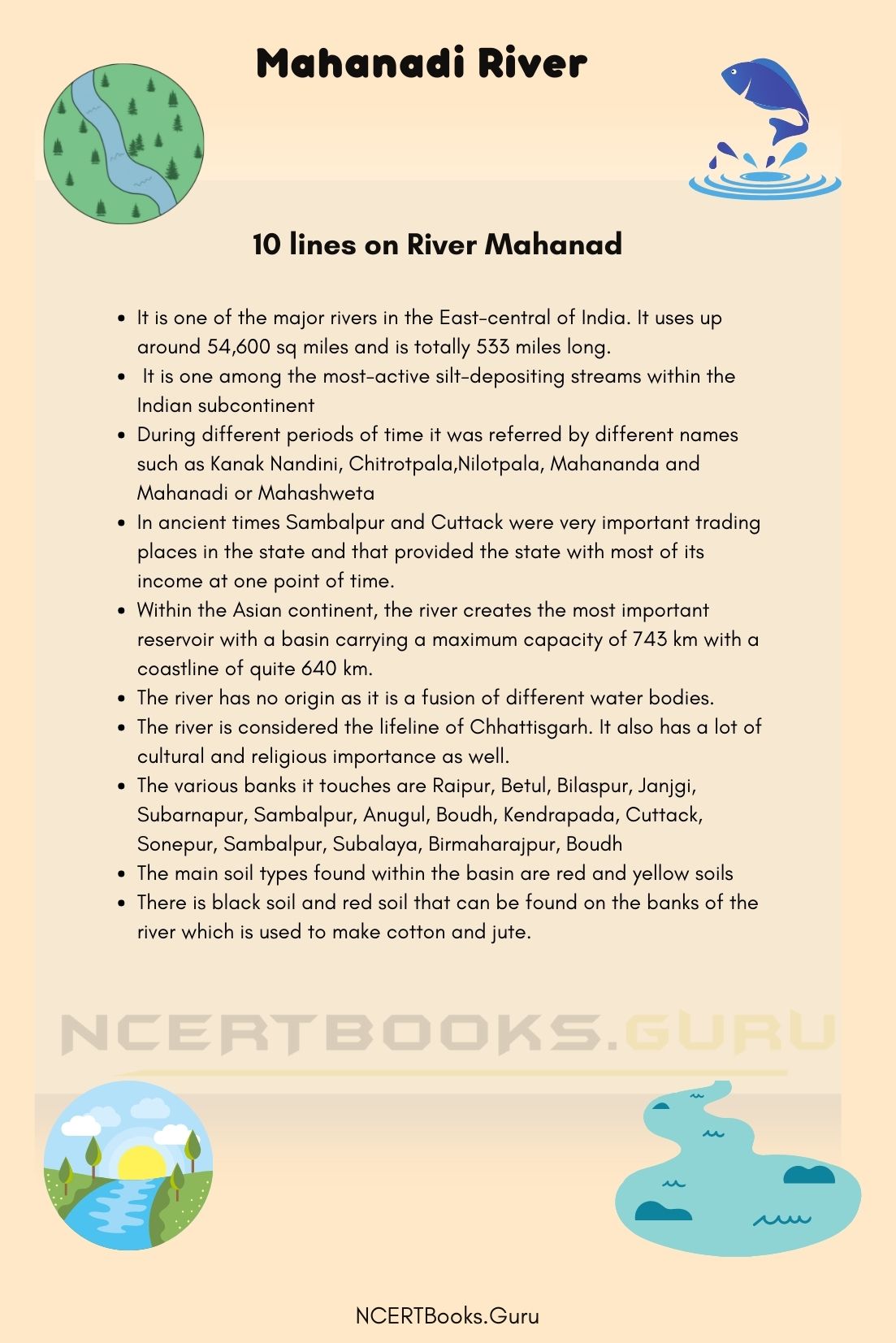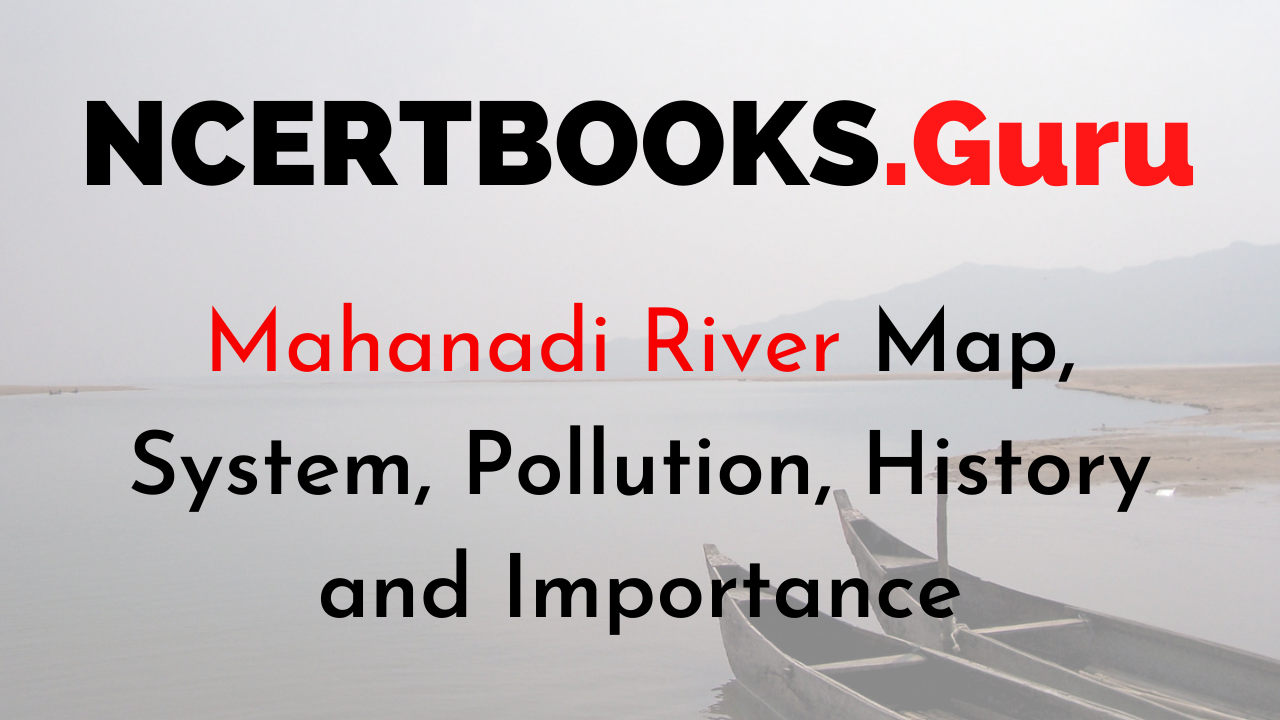It is one of the major rivers in the East-central of India. It uses up around 54,600 sq miles and is totally 533 miles long. It flows through Odisha, Chhattisgarh and Madhya Pradesh. Mahanadi river plays an important role as it provides water for agriculture and helps in the growth of fisheries in different areas of the state.
Top 10 Largest Rivers in India, you would also find the details about Indian River Systems and major rivers of India.
Mahanadi River Details
| Origin | No defined origin. |
| Other names | kanak nandini, Chitrotpala, Treata Yoga |
| length | 858 Kilometers |
| Average Depth | Maximum -877m and minimum-193m |
| Average Water Flow | 2,000,000 cubic feet per second |
| Importance | Transport, irrigation, fisheries, tourism |
| Reasons for pollution | Sewage disposal |
About the Mahanadi River
This is an active river that starts from the uphills of Chhattisgarh. It is one among the most-active silt-depositing streams within the Indian subcontinent. The upper course of Mahanadi runs north as an insignificant stream that goes on to draining the eastern Chhattisgarh Plain. Then after meeting with Seonath River, below Baloda Bazar, it turns east and enters Odisha, its flow augmented by the drainage of hills to the north and south.
The Hirakud Dam which is found in Sambalpur, the river has formed a man-made lake 55 km long; the dam has several hydroelectric generators. Right below the dam, the Mahanadi river turns along south to a tortuous course, by just barely touching the Eastern Ghats through the thick forests. Along the east, it enters through Odisha plains which is close to Cuttack and from there it enters the Bay of Bengal through several channels. .
Mahanadi River History
The river’s name comes from the Sanskrit word Maha which means great and the word Nadi which means river. During different periods of time it was referred to by different names such as Kanak Nandini, Chitrotpala,Nilotpala, Mahananda and Mahanadi or Mahashweta. It uses up around 54,600 sq miles and is totally 533 miles long. It flows through Odisha, Chhattisgarh and Madhya Pradesh.
The River Mahanadi has its historical roots deeply associated with the places it flows through that is Odisha, it deposits more slit in this region than any other river in the country. In ancient times Sambalpur and cuttack were very important trading places in the state and that provided the state with most of its income at one point of time. Sambalpur was an important city for the business of diamonds.The river has a lot of historical importance and recently an ancient temple has resurfaced in Odisha, the temple’s architecture predates the 15th or 16th century.
Mahanadi River Map
For the initial 80 km of the river, it runs consistent with a northerly itinerary and connects with the eastern parts of the Raipur district in Chhattisgarh. The river is sort of thin at this place, the general span of this Basin doesn’t pass 500-600 meters. After which, the river moves into the old Bilaspur District in Chhattisgarh where it connects the primary important tributary of the river, which is understood as Seonath.
Then the Mahanadi River meets the Seonath from there combined stream runs to the east across the remainder of its itinerary. The Hasdeo and Jonk Rivers meet the river during this area before getting into Orissa, once it’s completed around 50% of its overall stretch. on the brink of the Sambalpur City, the river is barraged by the Hirakud Dam, which is the biggest earth fill dam within the world. A fused construction of stonework, soil, and concrete that covers the length of the dam (24 km). The stretch of the river covers two dams. It also covers two mountains – the Chandili Dunguri on the proper and Lamdungri on the left. Within the Asian continent, the river creates the most important reservoir with a basin carrying a maximum capacity of 743 km with a coastline of quite 640 km.
Mahanadi River system
Within the Asian continent, the river creates the most important reservoir with a basin carrying maximum capacity of 743 km with a coastline of quite 640 km.It flows through Odisha, Chhattisgarh and Madhya Pradesh. The upper course of Mahanadi runs north as an insignificant stream that goes on to draining the eastern Chhattisgarh Plain. Then after meeting with Seonath River, below Baloda Bazar, it turns east and enters Odisha, its flow augmented by the drainage of hills to the north and south. The various banks it touches are Raipur, Betul, Bilaspur, Janjgi, Subarnapur, Sambalpur, Angul, Boudh, Kendrapara, Cuttack, Sonepur, Sambalpur, Subalaya, Birmaharajpur, Boudh.
Mahanadi River Pollution
Today rivers are plagued with problems of pollution, extensive usage of their water resources and the gradual decay in water quality thanks to the disposal of each possible sort of waste. The release of biomedical waste, industrial sewage and municipal sewage has created very toxic areas in several parts of Odisha.
What was once a flowing river with clear water has witnessed a deterioration in its water quality within the last four decades, primarily thanks to severe pollution. Usage of water from Mahanadi was already extensive within the state thanks to agriculture and industry. Over a previous couple of decades, increase in towns, cities and concrete clusters has resulted in additional problems of household waste disposal, small factories disposing chemical waste into the river’s bank and the excessive use of the water has also caused it to fall in such a shape
Mahanadi Rivers Importance
The river is considered the lifeline of the Chhattisgarh. It also has a lot of cultural and religious importance as well. It has also provided trade and agriculture for the state of Odisha.
The basin of the river receives about 90% of its rainfall during the monsoon season. Generally, the southwest monsoon sets by the centre of June over the whole basin and remains active till the top of September. The spatial variation in rainfall is moderate within the basin. The formation of depressions within the Bay of Bengal causes cyclones, which cause widespread heavy rains leading to floods and destruction.
The average annual runoff of Mahanadi is 66.9 Billion kiloliters. Totally The t basin receives rainfall in uneven patterns thus drought is prevalent in some districts. Total fourteen districts within the basin are covered under the Drought Prone Area programme.
Districts Jagatsinghpur, Puri and Kendrapara which are situated near coastal parts of Mahanadi face water logging problems.
The main soil types found within the basin are red and yellow soils. There is also black soil and mixed red soil that occur in parts of the Sundargarh, Sambalpur, andBolangi districts of Orissa. Laterite soil is found within the lower parts of Orissa. The deltaic soil is found within the coastal plains of the Mahanadi. Black soil and sandy soil with Kankar are the most soils found within a part of the basin lying in Chhattisgarh.
Short Essay on Mahanadi River
The Mahanadi river is one among the prominent rivers in the country. It holds major importance over the states of Odisha, Chhattisgarh and Madhya Pradesh as it provides for a lot of the agricultural practices and the various religious and cultural aspects of the state.It is one among the most-active silt-depositing streams within the Indian subcontinent. The upper course of Mahanadi runs north as an insignificant stream that goes on to draining the eastern Chhattisgarh Plain.
The River Mahanadi has its historical roots deeply associated with the places it flows through that is Odisha, it deposits more slit in this region than any other river in the country. The river’s name comes from the Sanskrit word Maha which means great and the word Nadi which means river. It uses up around 54,600 sq miles and is totally 533 miles long. . In ancient times Sambalpur and Cuttack were very important trading places in the state and that provided the state with most of its income at one point of time. The river has helped provide trade and business for the states it flows through.
Within the Asian continent, the river creates the most important reservoir with a basin carrying maximum capacity of 743 km with a coastline of quite 640 km. The various banks it touches are Raipur, Betul, Bilaspur, Janjgi, Subarnapur, Sambalpur, Angul, Boudh, Kendrapara, Cuttack, Sonepur, Sambalpur, Subalaya, Birmaharajpur, Boudh.

10 Lines on River Mahanadi
- It is one of the major rivers in the East-central of India. It uses up around 54,600 sq miles and is totally 533 miles long.
- It is one among the most-active silt-depositing streams within the Indian subcontinent
- During different periods of time it was referred by different names such as Kanak Nandini, Chitrotpala,Nilotpala, Mahananda and Mahanadi or Mahashweta
- In ancient times Sambalpur and Cuttack were very important trading places in the state and that provided the state with most of its income at one point of time.
- Within the Asian continent, the river creates the most important reservoir with a basin carrying a maximum capacity of 743 km with a coastline of quite 640 km.
- The river has no origin as it is a fusion of different water bodies.
- The river is considered the lifeline of Chhattisgarh. It also has a lot of cultural and religious importance as well.
- The various banks it touches are Raipur, Betul, Bilaspur, Janjgi, Subarnapur, Sambalpur, Anugul, Boudh, Kendrapada, Cuttack, Sonepur, Sambalpur, Subalaya, Birmaharajpur, Boudh
- The main soil types found within the basin are red and yellow soils
- There is black soil and red soil that can be found on the banks of the river which is used to make cotton and jute.
FAQs on Mahanadi River
Question 1
What is the source for the Mahanadi river?
Answer:
The river’s source is a fusion of hilly torrents so the exact source of the river cannot be defined
Question 2
Where does Mahanadi get its name from?
Answer:
The river’s name comes from the Sanskrit word Maha which means great and the word Nadi which means river. During different periods of time it was referred by different names such as Kanak Nandini, Chitrotpala, Nilotpala, Mahananda and Mahanadi or Mahashweta.
Question 3
Which dam is built over Mahanadi?
Answer:
The Hirakud Dam is built over the Mahanadi river.
Question 4
State the importance of the Mahanadi river.
Answer:
The river is considered the lifeline of Chhattisgarh. It also has a lot of cultural and religious importance as well. It has also provided trade and agriculture for the state of Odisha.
